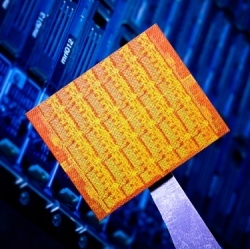
There’s a pair of breakthroughs when it comes to the field of silicon photonics. Scientists have managed to develop a new method that could allow for the trajectory of experimental improvement in microprocessors that began nearly half a century ago, allowing for increasingly faster electronics.
The new technique involves allowing microprocessors to use light instead of electrical wires to communicate with transistors on a single chip. This could potentially lead to extremely energy-efficient computing and a continued skyrocketing of computing speed in the future.
In fact, the new method actually proves Moore’s Law. First laid out in 1965, this law predicted that the size of the transistors used in microprocessors could be shrunk by half about every two years for the same production cost, allowing twice as many transistors to be placed on the same-sized silicon chip. The effect would be a doubling of computing speed every couple of years.
Yet in recent years, this doubling of computer speed hasn’t happened. While transistors continue to get smaller, halving their size no longer leads to doubling since the limiting factor in microelectronics is now the power that’s needed to keep the microprocessors running. Using light waves instead of wires for microprocessor communication functions, though, could solve this issue. It would eliminate limitations now faced by conventional microprocessors and extend Moore’s Law into the future. That’s why researchers decided to focus on light communication.
Optical communication circuits, known as photonics, have two main advantages over communication that relies on wires. Using light has the potential to be energy efficient, and a single fiber-optic strand can carry a thousand different wavelengths of light at the same time, allowing for different communications to be carried simultaneously and eliminating cross talk.
"In order to convince the semiconductor industry to incorporate photonics into microelectronics you need to make it so that the billions of dollars of existing infrastructure does not need to be wiped out and redone,"
